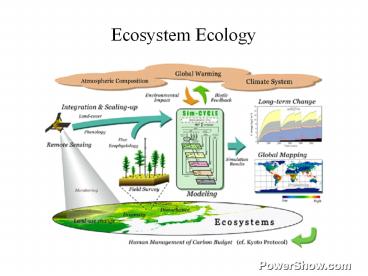Ecosystem Ecology - PowerPoint PPT Presentation
Title:
Ecosystem Ecology
Description:
Energy enters most ecosystems in the form of sunlight. ... Ecosystem ecologists view ecosystems as transformers of energy and processors of ... – PowerPoint PPT presentation
Number of Views:506
Avg rating:3.0/5.0
Title: Ecosystem Ecology
1
Ecosystem Ecology
2
Ecosystem Studies
- An ecosystem consists of all the organisms living
in a community as well as all the abiotic factors
with which they interact. - The dynamics of an ecosystem involve two
processes that cannot be fully described by
population or community processes and phenomena
energy flow and chemical cycling. - Energy enters most ecosystems in the form of
sunlight. - It is converted to chemical energy by autotrophs,
passed to heterotrophs in the organic compounds
of food, and dissipated as heat. - Chemical elements are cycled among abiotic and
biotic components of the ecosystem.
3
Variation in Ecosystem Size
Pitcher plant to Planet Earth
4
Ecosystem Function
- Ecosystem ecologists view ecosystems as
transformers of energy and processors of matter. - We can follow the transformation of energy by
grouping the species in a community into trophic
levels of feeding relationships.
5
Trophic Levels
6
Great Lakes Food Web
Primary Producers
Decomposers
7
Energy Flow
- Most primary producers use light energy to
synthesize organic molecules, which can be broken
down to produce ATP. - The amount of photosynthetic production sets the
spending limit of the entire ecosystem
8
The Ecocycle at Cellular Level
9
Global Energy Input
- Every day, Earth receives approximately 1023
joules of solar radiation. - The intensity of solar energy striking Earth
varies with latitude, with the tropics receiving
the greatest input. - Most of this radiation is scattered, absorbed, or
reflected by the atmosphere. - Much of the solar radiation that reaches Earths
surface lands on bare ground or bodies of water
that either absorb or reflect the energy. - Only a small fraction actually strikes algae,
photosynthetic prokaryotes, or plants, and only
some of this is of wavelengths suitable for
photosynthesis. - Of the visible light that reaches photosynthetic
organisms, only about 1 is converted to chemical
energy.
10
Global Energy Input
- Although only a small amount of light reaches
plants, primary producers produce about 170
billion tons of organic material per year. - Total primary production in an ecosystem is known
as gross primary production (GPP). - This is the amount of light energy that is
converted into chemical energy per unit time.
11
The Two Most Important Biological Reactions
- Photosynthesis
- Energy
- 6CO2 12H2O gt C6H12O6 6O2 6 H2O
- Respiration
- C6H12O6 6O2 6H2O gt 6CO2 12 H2O energy
12
Energy Flow and Nutrient Cycling
- Nutrients and matter are cycled among abiotic and
biotic components of the ecosystem. - Energy, unlike matter, cannot be recycled.
- An ecosystem must be powered by a continuous
influx of energy from an external source, usually
the sun. - Energy flows through ecosystems, while matter
cycles within them.
13
Energy and Material Flow in Ecosystems
14
Energy Storage
15
Ecosystem Roles for Organisms
- Organisms can be broadly classified based on how
they get their energy - Producers (autotrophs) - these organisms
manufacture complex organic molecules from simple
inorganic molecules using some source of energy -
solar or chemical for some bacteria - Consumers (heterotrophs) - they eat other living
things to get their nourishment - consumers that eat producers (plants) are primary
consumers or herbivores - consumers that eat primary consumers are
secondary consumers or carnivores, etc. - Detritovores consume the organic matter in plant
or animal remains - Decomposers break down organic molecules into
simple inorganic molecules for their nourishment
- bacteria and fungi
16
A Simple Ecological Pyramid
17
A More Complex Food Web
18
Productivity
- GPP - The total amount of energy assimilated by
plants during photosynthesis is known as gross
primary production. - The rate of GPP depends upon availability of
water, temperature, and availability of
nutrients - thus we see the highest rates of GPP
in systems that are supplied with large amounts
of water and which have fairly warm temperatures. - NPP - The amount of energy that is stored in
plant bodies and thus available to consumers is
called net primary production. - NPP GPP - respiration
19
Productivity by Global Area
20
(No Transcript)
21
Productivity Relative to Temperature and
Precipitation
22
Aquatic Productivity
- In aquatic systems, GPP depends upon availability
of light and nutrients - Vast areas of tropical open ocean have low
productivity while areas near coast near polar
regions have high productivity - why is this?
main limit to productivity in oceans is due to
availability of nutrients
23
Marine Net Primary Productivity
Red most productive, Purple least productive
24
Light Penetration in Water
25
Upwelling and Productivity
26
Energy Flow in Grazer and Decomposer Food Webs
27
Energy Flow in Four Types of Ecosystems































